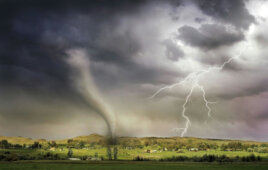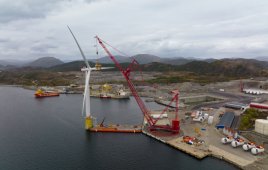By Gareth Brown, CEO, Clir Renewables
In February 2021, Texas faced a disastrous power failure as a result of an unexpectedly severe winter storm. Natural gas wells froze, transmission substations went offline, and the grid operator was forced to initiate rolling blackouts, leaving millions of homes and businesses without power for days. This extreme cold combined with humidity caused a number of wind turbines to visibly freeze over.
 However, while 4 GW of wind energy did go offline, the majority of the state’s wind turbines stayed online, helping to mitigate the disaster with consistent, if low, power production.
However, while 4 GW of wind energy did go offline, the majority of the state’s wind turbines stayed online, helping to mitigate the disaster with consistent, if low, power production.
The immediate reaction from regulators has been to call for winterization of power assets across Texas to prevent a repeat of this disaster. Many wind farm owners are considering whether it is worth following suit to increase winterization of their turbines to extend operational capacity and potentially take advantage of higher price production periods.
Here are the three key steps owners must consider in order to optimize their wind farms and give them the best opportunity to supply low-cost, clean energy despite extreme weather events.
- Predicting performance through cold weather
Icing can impact turbine performance in a number of ways. In the first instance, ice can build up on the turbine and directly reduce aerodynamic performance. As the ice and load on the blade builds to critical levels, the turbines are shut down to prevent mechanical damage.
In the week of the Texas disaster, expected output was already below average due to the low winds forecast – this meant that any additional generation loss due to the cold was minimized. However, in order to plan ahead for future extreme weather and prevent lost output during periods of high power prices, wind farm owners need to monitor and analyze asset performance in the context of both expected resource and environmental conditions, as well as turbine health.
In order to model how turbines will perform through cold weather, the first step is to build a baseline for turbine performance in “normal” conditions. This enables wind farm owners to detect when icing is occurring, the money it is has cost them to date, and ultimately allows them to forecast future year performance and variability.
Advanced data analytics, such as the use of artificial intelligence and machine learning, are key to providing this full understanding of turbine performance and modeling “worst-case scenarios” based on all available data.
- Smart control to prevent ice buildup
Ice can cause long-term underperformance in cold conditions. A combination of freezing temperatures and humidity – for example, when a blade tip moves through freezing clouds – results in the formation of rime ice on the blade surface. This ice then propagates, reducing the aerodynamic performance of the turbine. The weight of ice on a blade triggers turbine shutdown – both as a safety measure and to protect the turbine from being overburdened. The turbine will stay offline until the ice melts, which can take weeks if low temperatures persist.
Preventing ice buildup at some sites can be as simple as powering down the turbine during periods of cloud coverage to prevent continued exposure of the blades to cold and humidity, as a spinning blade will accrue ice much faster than a stationary blade. Although this causes an immediate drop in power production, the turbine can then be powered up again once conditions clear and temperatures rise, while a more heavily iced-over turbine would stay offline for extended periods. This strategy can be incredibly useful for sites that experience long durations of cold but low frequency of icing.
- Retrofitting – when it makes sense
Anti-icing and de-icing systems have been developed to speed up the removal of ice from a turbine. Most commonly, these take the form of heaters in the blade that prevent or remove ice buildup, enabling turbines to operate in temperatures below freezing. Water-resistant coatings can also be applied to blades, preventing the adhesion of precipitation and the formation of ice crystals.
 These retrofits are commonplace in northern Europe and North America as the climate is regularly cold and humid. Owners can be sure that the additional cost of installing these systems will pay off since they expect conditions to drop below freezing every year.
These retrofits are commonplace in northern Europe and North America as the climate is regularly cold and humid. Owners can be sure that the additional cost of installing these systems will pay off since they expect conditions to drop below freezing every year.
However, the relative frequency of extreme cold snaps in states like Texas has to be considered before owners invest in anti-icing systems, as this technology can raise the capex of projects by 6%. If an extreme cold weather event only takes place once in 25 years, retrofitting anti-icing systems could raise the cost of development – and ultimately, the levelized cost of energy for that project – without significant return on investment.
Additionally, anti-icing systems themselves need to be maintained in order to prevent mechanical or electrical failure when they are most needed. In northern regions where these systems are often in use, it is easy to detect when an anti-icing system has broken down and fix it immediately ahead of the next cold spell. However, if these systems are rarely used, a technical fault can be missed for years, preventing the technology from coming online when it is most needed.
In order to validate investment in anti- and de-icing systems, owners have to be careful to model wind farm performance through expected cold weather but also consider the likelihood that events such as the Texas winter storm will repeat in the lifetime of the project.
Keeping costs low has enabled Texas to lead the world in installing wind capacity – and any approach to mitigate extreme weather events has to ensure that additional costs will ultimately pay off.
 Gareth Brown is CEO of Clir Renewables, a renewable energy AI software company. Gareth has over a decade of experience leading identification, development, construction, financing and operation of renewable energy assets for a world leading renewable energy technical consultancy. He is an entrepreneur, chartered engineer with the IMechE, and has degrees in mathematics and mechanical engineering.
Gareth Brown is CEO of Clir Renewables, a renewable energy AI software company. Gareth has over a decade of experience leading identification, development, construction, financing and operation of renewable energy assets for a world leading renewable energy technical consultancy. He is an entrepreneur, chartered engineer with the IMechE, and has degrees in mathematics and mechanical engineering.
Filed Under: Featured





One must remember that de-icing has been on airplanes for nearly 100 years, and is well developed. It is also practical to measure the amperage going through a contactor or circuit breaker, so monitoring the amperage of the blade heaters is important and will give indications of failed heating elements.
Slick surfaces will work well in areas that typically don’t see 31F weather very often. Black blade surfaces might be useful in some locations?
Another way that some planes shed ice is flexing the wings. This might be possible with wind turbines. Perhaps stopping generation while allowing the blades to freewheel at a higher RPM to shed the ice with centrifugal force.
Hi, I have been in the wind industry for 18+ years performing site operations Manager in Canada, with consistant yearly data and experience with ice build up on the leading edge of the blades.
I agree.
Monitor the data to and build your base line for wind speeds from 3m/s – 20m/s vs production.
I experienced ice conditions in the fall and spring.
Closely monitor the weather, conditions for icing were between +1 degree and -5 at 95+ humidity, if you are in the field at the time a good indication is higher blade noise!
I always recommend pausing the turbines when an event is passing through.
On several occasions this has prevented extreme build up of ice though will not stop accumulation all together, One event where i paused i was back on line after freezing mist dissipated and the neighbouring wind facilities were down for several days, some WTG for weeks.
Freezing mist is not common after -5.
One particua way to shed ice after an event to quicken shedding is to yaw the WTG’s in the direction to face the sun, (if the wind is below 5m/s) and ramdomely select a wtg and manual set gen speed to approximately 200rpm, with techs viewing from a distance to see if sheeding is occuring and from scada to watch for generator ramp up, if it is very slow and no sheding pause and wait an hour or so and try again, some turbines will respond quicker due to location on site where the sun might be more visible. Also remember to auto yaw back into position if icing is still present if home time!!
Another way we monitored was to have (depending on how many WTG on site) keep reference turbines in run, for the 50 V90’s i had we would have four around the perimeter of the site to see for improvements in rpm and/or production to get the site back into service asap.
I hope you found this of interest